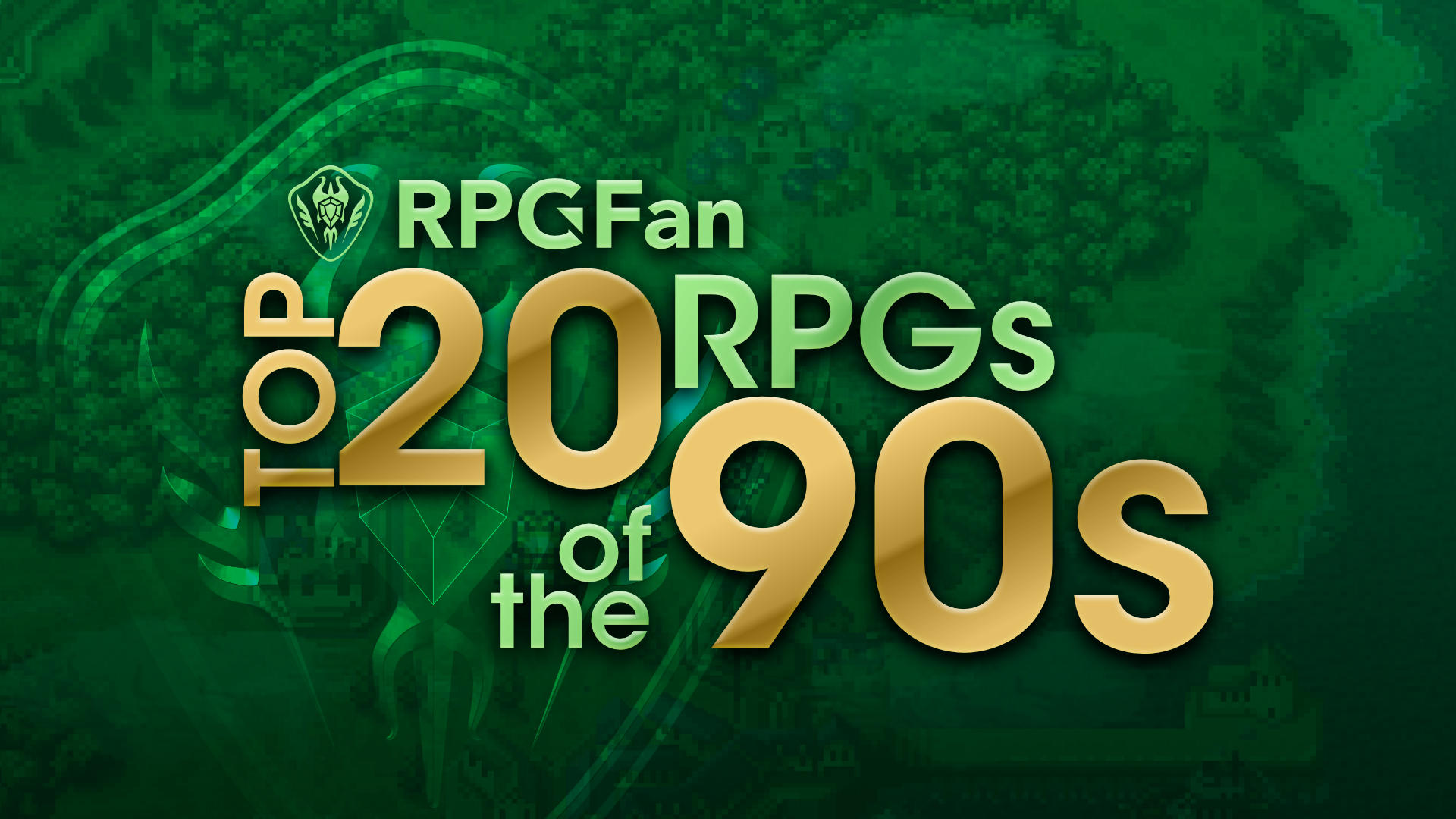Ah! The good old 90s! The editors here at RPGFan have fond memories of that decade because it was the period that most of us really got into the RPG genre. It was a time when RPGs were a “niche” genre, and we sometimes had to wait months before we saw the release of another on our favorite console.
RPG titles back then weren’t big blockbuster sellers like the Mass Effects, Dragon Ages, Fables and Fallouts of today. We counted ourselves lucky when an RPG made its way into our shores from Japan. Of course, we were denied many RPGs from that period like two of the first five Final Fantasy games, the two Super Nintendo Dragon Quest games, and some gems like Seiken Densetsu 3 and Bahamut Lagoon. Our patience paid off, however, and we eventually saw a more steady flow of releases as RPGs became more and more popular over the decade.
The 90s saw the last half of the 8-bit era, the entire 16-bit era, and a good chunk of the 32-bit era. Despite the fact that there were fewer RPGs in the 90s than in the decade that would follow, we can certainly say that there wasn’t a lack of quality.
To commemorate this decade of great RPGs, we here at RPGFan decided to compile a list of the Top 20 RPGs of the 90s. Of course we didn’t take this task lightly, and we worked pretty hard for the last couple of months to poll the various RPGFan editors about their favorite RPGs, make them grade every RPG they played, compile the results, and find a way to rank them so that the results reflected the overall opinion of our combined staff: no easy task.
In the end, we’re pretty happy with the result and we’re proud to present you with the official RPGFan Top 20 RPGs of the 90s. We hope you enjoy!
#20: Final Fantasy IV
Super Nintendo
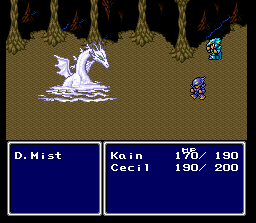
It’s hard to imagine a “classic” RPG with a more divided fanbase than Final Fantasy IV (Final Fantasy II in its original US release). Some players loved the straightforward heroic journey, the massive cast of colorful characters, and the consistent themes of family and redemption. Others found the game slow-paced, simplistic, and flat. Whatever your perspective, no one can argue with the massive success of the game, both as one of the first major RPGs released in the US for the then-fledgling Super Nintendo, and later as a continually re-released classic title on nearly every platform in existence. Final Fantasy IV was once the very prototype of the JRPG with its turn-based battle system, dependence on grinding levels, and extensive world. Though it may not have aged as gracefully as other contemporaries, Final Fantasy IV remains an exemplar of the old-school traditional RPG.
#19: Xenogears
PlayStation
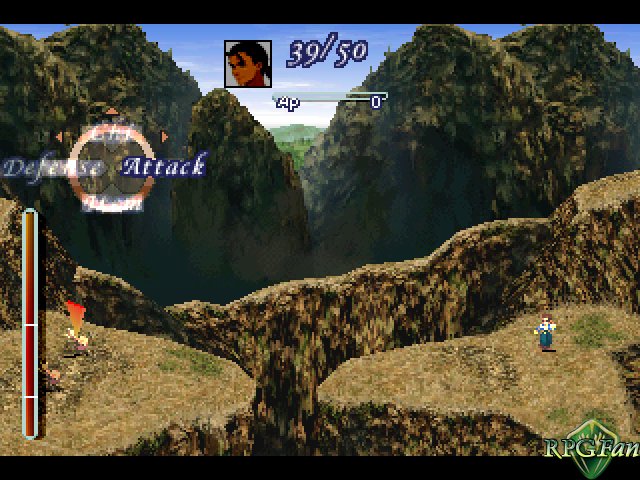
Along with Final Fantasy VII, Xenogears has only plummeted in popularity since its release, as more and more gamers merely parrot what they read and call it an opinion, allowing the breezes of trend to carry them away. Despite what many claim is an enormously flawed game with a few good ideas, Xenogears is in reality a great game with a few mishaps, many of which come simply from age. Even today, few Japanese RPGs are quite as spirited and playable as Xenogears.
The tale of Xenogears exemplifies the classic JRPG: vast and varied in setting, character, gameplay, and theme. Atmospheric towns full of secrets, mini-games, and rousing music. Scenes of great horror, joy, love, and emotion with veiled motivations and uncertain allies. Various modes of battle, plenty of random fights, and noisome villains. To these JRPG strengths, Xenogears adds a psycho-religious plot, a helping of science fiction, and a flavor unlike anything. Nothing has felt like Xenogears before or after its release, and I doubt anything ever will. Long live Citan Uzuki.
#18: Super Mario RPG: Legend of the Seven Stars
Super Nintendo
The first Mario-themed RPG, released in 1996, had the unique trait of appealing to two different types of gamers: the then-growing Squaresoft and RPG fanbase and the more casual Nintendo- and Mario-loving crowd. As one might imagine, since Super Mario RPG was developed by Nintendo and Squaresoft, the title satisfied both crowds. Even as it retained all things Mario including mushrooms, pipes, familiar enemies, floating question blocks, and Princess Toadstool and Bowser (who could throw Mario at enemies – how awesome is that?) as party members, The Legend of the Seven Stars still stood apart from other titles that happened to star Italian plumbers. Joining Mario were original characters such as the wizard Geno and the ever-emotional Mallow, and together they went off to fight unusual, unique bosses like Booster and oversized knives. Lastly, it wouldn’t be a Squaresoft RPG without the trademark RPG elements or the optional Final Fantasy-themed boss Culex.
If nothing else, Super Mario RPG: The Legend of the Seven Stars served as a clever way to introduce more Nintendo gamers to our beloved genre.
#17: Shadowrun
Sega Genesis
Shadowrun‘s cyberpunk setting borrowed liberally from William Gibson’s Neuromancer and a little from Ridley Scott’s Blade Runner as well, creating a distinctive world where cybernetics are ubiquitous, magic has returned, and everything has a price. And yet, despite several attempts to build a compelling game in the Shadowrun universe, only the 1994 Sega Genesis release ever succeeded in capturing the potential and wonder of the popular pen-and-paper RPG. Taking the role of Joshua allowed the player to explore the greater Seattle sprawl in an open-ended fashion, taking one of three very different roles: street samurai, decker, or gator shaman. At the same time, Shadowrun had a clear, focused narrative that guided the player from the alleys of Puyallup Barrens to the hi-tech offices of the massive Renraku Arcology and finally to the elven forests of Sinsearach. The combination of open-ended gameplay and the compelling story and characters of the Shadowrun universe made Shadowrun for the Genesis one of the greatest RPGs of the 16-bit generation, which is no mean feat.
#16: Shining Force II
Sega Genesis
In the RPG world, a sword-wielding, silent protagonist who saves fancy-haired royalty is a cliché. Of course, in order for something to be a cliché, several instances of said plot device need to flood the zeitgeist. Shining Force II may be one of many predecessors of ye olde scary-faced-king-steals-the-princess, but it’s one of the best. Before this MacGuffin morphed from charm to chore, Shining Force II solidified itself not just as one of the first successful strategy RPGs, but as an atmospheric tale of good versus evil.
Combine the excellent storytelling with engrossing music whose style has never since been replicated, and you have yourself a masterpiece. To match the package, it included perfectly retro 16-bit graphics characteristic of the series – up close portraits and all. Shining Force II has and will continue to withstand the torrents of time, having proven fun in its humility and simplicity almost twenty years later. If you haven’t experienced one of the originators of chivalrous heroism, then turn to this classic and understand why so many developers since have copied the formula.
#15: Panzer Dragoon Saga
Sega Saturn
Panzer Dragoon Saga is often hailed as the best RPG you’ve never played. This amazing piece of software was released in limited quantity on the Sega Saturn in 1997, the year Final Fantasy VII was released on the more promising Sony PlayStation platform. Too bad, because Panzer Dragoon Saga gave its exclusive audience an unforgettable experience that words cannot encompass.
Merely writing about the game can’t do it justice. The darkly immersive world; the innovative battle system that’s seamless, strategic, and has yet to be duplicated; the memorable characters in an emotionally charged plotline; the stellar soundtrack and voicework in both Japanese and the Panzer language written specifically for the game – all lend that feeling of being in a living, breathing, alien world. To this day, Panzer Dragoon Saga remains one of the most unique and innovative Japanese RPGs ever released. There has never been a game like it and many are doubtful that there ever will be again. It makes you wonder what the current state of RPGs would be like if Panzer Dragoon Saga been the floodgate-opening watershed title instead of Final Fantasy VII back in 1997.
#14: EarthBound
Super Nintendo
It’s tempting to simply describe EarthBound as “whimsical”, but that doesn’t give it enough credit. Yes, the game’s protagonist is named “Ness”, as in “NES” as in “Nintendo Entertainment System.” Yes, your quest is revealed by an alien named Buzz Buzz that is killed by the protagonist’s mother after being mistaken for a dung beetle. And yes, your weapons include things like yo-yos and frying pans.
No doubt the game has a sense of humor. But it is humor with a tinge of distress much like some of the classic Donald Bluth animated works or even fairy tales by the Brothers Grimm. Behind it all there is something sinister at work, and even though our heroes are children, they have been thrust into a situation where the stakes are truly terrible.
It is not an easy thing to get your hands on this game, and the modern gamer may find the amount of grinding necessary at certain points of the game to be too much. But EarthBound is nevertheless a wonderful game belonging entirely to its time.
#13: Lunar: The Silver Star / Silver Star Story Complete
Sega CD / PlayStation
Lunar was a perfect example of the classic JRPG done right. It masterfully captured the spirit of adventure by catapulting players into an unknown world replete with endearing characters. The chemistry between party members was effortlessly natural, especially the budding romance of protagonist Alex and heroine Luna. The translation efforts of the now-defunct publisher Working Designs showed obvious dedication to excellence, full of clever dialogue and tasteful pop-culture references. Such exemplary localization was a rarity then, and has only recently seen equal contenders in the form of publishers like Atlus and XSEED.
Lunar proved that even a rudimentary story could be captivating if the characters were charismatic enough. This, combined with the strategic turn-based battle system, fully voiced anime cutscenes, and a plethora of goodies stuffed into the collector’s edition (for the PlayStation version), made for an amazing package that remains a hallmark of excellence for the genre.
#12: Fallout
Windows
For the uninitiated, the first few hours of Fallout can be confusing (to put it lightly). A little patience and thought, however, can unearth one of the greatest RPGs ever made. Hailing from an era that is truly dead today, Fallout is a world to explore; one just as detailed, gritty, and realistic as our own, even if there are humans transformed into ghouls from suckling the teats of a nuclear disaster. An intriguing story, impeccable atmosphere, black humor, and complex (if intimidating) gameplay brought an amazing mythos to life.
Along with a few other games on this list, they really don’t make them like this anymore, and such a cliché is not to be used lightly. Dialogue has lost its edge. World building has lost verisimilitude. Gameplay has lost… well, about 80% of its bulk. Simple mechanics have their place, but so do convoluted ones, and where better to explore a complex and sometimes baffling system than in an RPG, the mother of expansive rules systems?
#11: Fallout 2
Windows
Fallout and Fallout 2 are two of the highest-quality WRPGs that have ever existed and both hold the torch for different reasons. Fallout 2 is a little more quirky than its older brother and a little bit less serious. While it still takes place in the same gritty world, more of the onus is on the fact that this world is a farce on the “world of the future.” There’s no doubt that there’s much in Fallout 2 that’s broken – like many other WRPGs of the 90s, there are bugs abound, even after patching – but there’s so much quality material here, from the dialogue to the environments and locales to the immense customization, that there’s almost too much to love about Fallout 2.
#10: Castlevania: Symphony of the Night
PlayStation
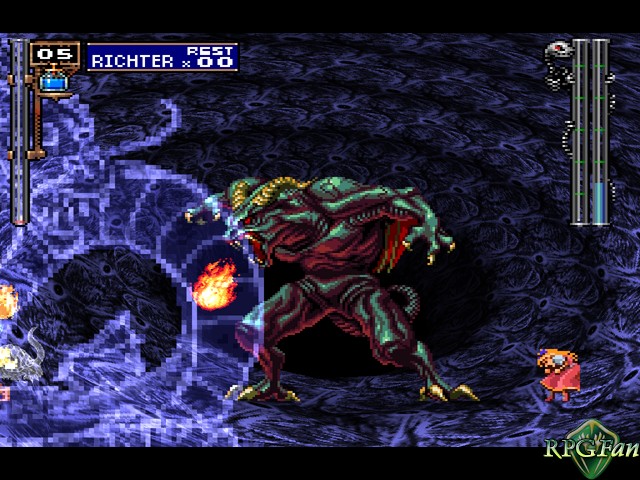
It’s doubtful Konami had any idea how much the release of Symphony of the Night in October of ’97 would shape the franchise. What was once a linear platformer, Castlevania embraced the multiple pathways found in CV3 and Rondo of Blood, giving us one of the most memorable environments in the history of video games. Dracula’s gothic abode was re-imagined into a twisting labyrinth of mystery and danger. The castle now resembled Samus Aran’s adventures on the planet Zebes, giving rise to the Metroidvania moniker that quickly became a franchise mainstay. The sense of exploration and discovery helped drive the player forward, and new powers and abilities allowed our hero, Alucard, to traverse new areas. Better yet, RPG elements infused him with stats and equipment necessary to bring the fight to his undead father. The hundreds of enemies residing on campus (nearly all coming from previous games and various mythological stories) often dropped rare and precious items, leading many gamers to murder hundreds of monsters for experience and loot.
But the best part of Symphony of the Night was the grand secret Konami somehow managed to keep for months. The collective gasp in the days before internet forums and FAQs must have been priceless. “What do you mean there’s a second castle and it’s upside-down?!”
#9: Final Fantasy VII
PlayStation
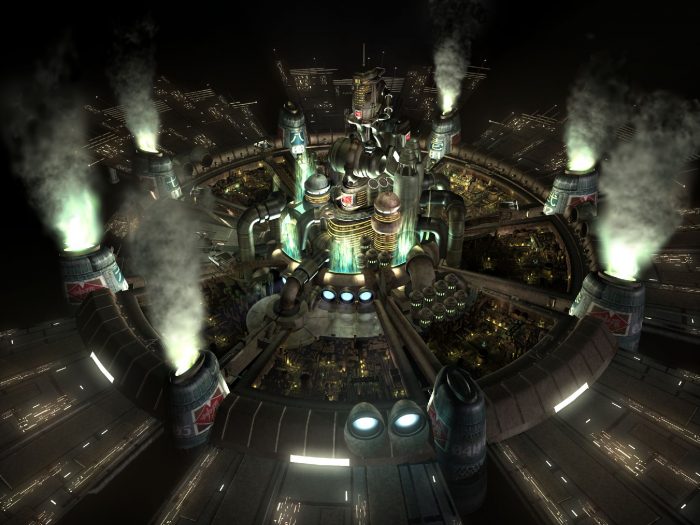
While its quality may be disputed by those with way too much free time, its influence can’t be denied; Final Fantasy VII has shaped the image of console RPGs, for good or ill. When it was released in 1997, it broke new ground in terms of aesthetics and storytelling for console RPGs. Environmental terrorism, unbridled capitalism, and environmentalist extremism were just some of the topics that the game delved into. Topics that had been merely touched upon by previous games were explored more deeply than any prior console RPG dared. Newer, more taboo topics were included to make it a game that actually took into account the fact that the player base was growing and maturing. While the game’s legacy has since been tarnished by the sloppy retconning the Compilation of Final Fantasy VII inflicted upon it, the original game, as a self-contained story and experience, is undoubtedly incredible.
#8: Baldur’s Gate
Windows

Although Baldur’s Gate was technically the second game released by the now mighty BioWare, it was certainly the game that started to make them a household name. The magnificent Infinity Engine which powered Baldur’s Gate would go on to handle not just a sequel, but the terrific Planescape: Torment (also featured on this list) as well as the Icewind Dale series.
Many games were developed based on the now old Advanced Dungeons and Dragons 2nd edition rules, but Baldur’s Gate got the spirit of those rules exactly right with real time combat that you could pause at will. Your lowly level 1 characters could be taken out in a single hit just like in the tabletop game as well, but this gave the game an even more epic feel as your characters became far more powerful.
For a fan of the Forgotten Realms setting, Baldur’s Gate was pure nirvana with appearances by famous characters like Drizzt and Elminster. But even those unfamiliar with the setting found themselves immersed in the world of Faerûn before long thanks in large part to wonderfully realized characters, in particular a classic villain in the form of the heavily armored Sarevok. The sequel to Baldur’s Gate is considered by many to be the best RPG of all time, but it all started here with the original Baldur’s Gate in 1998.
#7: Lunar: Eternal Blue
Sega CD
Many of us here at RPGFan have fond memories of this GameArts classic, especially considering that this website was originally created to be a Lunar fansite under the name LunarNet before becoming RPGFan. This Sega CD classic took everything that was good about the original Lunar and made it even better. Incredible music, beautiful anime cutscenes, great dialogue and a compelling story: this game had it all! The protagonists Hiro and Lucia are a fantastic couple; Lucia’s development over time from cold and alien to warm and truly human is something that Hiro learns to cope with. He never backs down, he’s never maudlin or whiny, yet he’s also a fair bit more manly than Alex from the first Lunar. Likable characters go a very, very long way in our book and Lunar 2 has one of the best cast of characters you can find in an RPG.
#6: Suikoden II
PlayStation
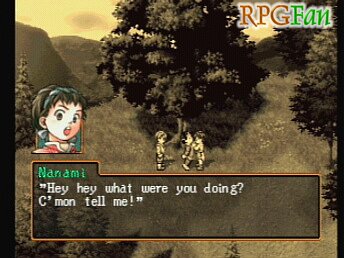
When it was released in 1999, Suikoden II was lost in the shadow Final Fantasy VIII, but now, over a decade later, Final Fantasy VIII can be found almost anywhere for $10 or less, while Suikoden II fetches well over $100 for a used copy on auction sites. It’s not hard to see why: Suikoden II combined a high quality story, memorable characters, beautiful aesthetics, and excellent gameplay mechanics to make what is considered by many to be one of the best RPGs on the PlayStation. With 108 unique characters, tons of hidden content and sidequests, and multiple endings, there was more than enough reason to play Suikoden II more than once. It has also aged incredibly well, surpassing even many RPGs released today in terms of overall quality. Despite the series’ fate being foggy at best recently, Suikoden II remains a classic and a reminder of those halcyon days where companies were not always controlled by sneering shareholders and braindead executives.
#5: Final Fantasy Tactics
PlayStation
Square experimented with nearly every franchise and genre during the early days of the PlayStation. Final Fantasy, of course, remained the tent-pole title that supported the company, but Square wasn’t afraid to try new things with their key moneymaking series. Perhaps their greatest achievement in experimenting with the FF formula came with Final Fantasy Tactics, a turn-based SRPG from the creator of Tactics Ogre. Taking the jobs found in numerous core titles, Square gave players the ability to create an army to take into battle. Knights, mages, ninjas, and even calculators clashed swords (and TI-89s?) on the battlefield in the name of honor and glory for kings and queens. With the ability to master every job for every character, Tactics allowed for an almost limitless amount of strategy and player choice.
But Final Fantasy Tactics may best be remembered for the amazingly intricate story Yasumi Matsuno and company were trying to tell. Admittedly, the original English translation was full of mistakes and borderline nonsensical at times. The rerelease on PSP gave the game’s script and dialogue new life, however, and helped to realize the original vision of the developers. Combining an amazing story with sublime gameplay makes Final Fantasy Tactics one of the best examples of the RPG genre even today.
#4: Phantasy Star IV
Sega Genesis
Phantasy Star IV was a game far ahead of its time and was, sadly, the last “classic” Phantasy Star title. Originally released in Japan at the end of 1993, it was one of the first truly cinematic games, achieving this through a series of comic book-like scenes, gripping music, and worthwhile characters. Combat was also well ahead of its time, with combination attacks, quick battles, and most importantly, combat macros. Allowing players to set up more than 10 sets of commands, this made standard battles even speedier without sacrificing any of your party members – something that modern games like Persona’s auto-battle option does. That’s not to say that Phantasy Star IV is without faults, but when the biggest faults you can think of about a game almost two decades old is that, “the inventory system is a little awkward,” you know that the developers made a world-class game. Phantasy Star IV is a masterpiece that can compete with the best JRPGs of today.
#3: Planescape: Torment
Windows
Planescape: Torment is known for its excellent and original setting: Sigil, City of Doors. It’s known for its dialogue (and there’s plenty of it), and it’s known for having unique party members, such as a floating, talking skull. It’s less well known for its gameplay, which is nevertheless addictive and engaging. Some also know it for what may be the best story in the history of video games.
“There are two secrets to becoming great. One is never to reveal all that you know.” So says the Book of Pestilential Thought, an insidious item placed behind some anonymous door in Sigil. PS: Torment takes the damnable book’s advice, revealing much, while never quite all, over the course of the game, feeding the player just the knowledge he needs to continue playing, but never quite what he wants. In the end, one has the feeling that this game, this world, still has not revealed everything, no matter how many doors one has opened. The feeling that there are so many more doors to look behind, despite the fact that this is just an RPG, and an old one at that. It can’t possibly contain the world. Then again, who knows? There’s always another door.
#2: Final Fantasy VI
Super Nintendo
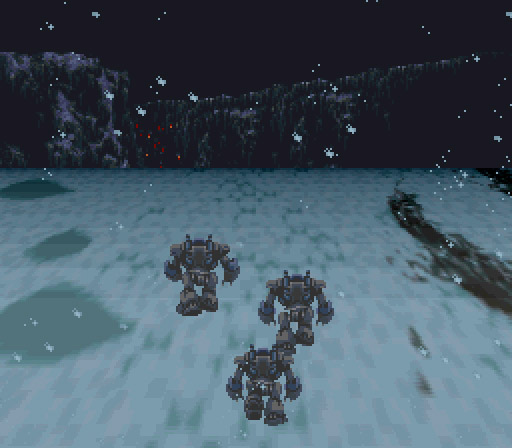
Final Fantasy VI has everything: A colorful cast of characters that all share the spotlight; the convincingly maniacal villain with a fondness for poison and fire and a dislike for sand that succeeds in destroying the world; and one of Nobuo Uematsu’s most memorable soundtracks that set the perfect tone for those touching scenes. The game’s final battle and Celes Chere’s opera performance also stand out as some of the most memorable scenes in the history of RPGs.
But what Final Fantasy VI pulls off especially well are its sidequests. Instead of menial tasks and fetch quests, the character-driven quests made you actually want to jump on the airship and search for your friends (which are all scattered across the World of Ruin). With both moments and characters ranging from the light-hearted to the more serious, FFVI has a charm not often seen in the 16-bit era, let alone in the more recent generations of JRPGs.
#1: Chrono Trigger
Super Nintendo
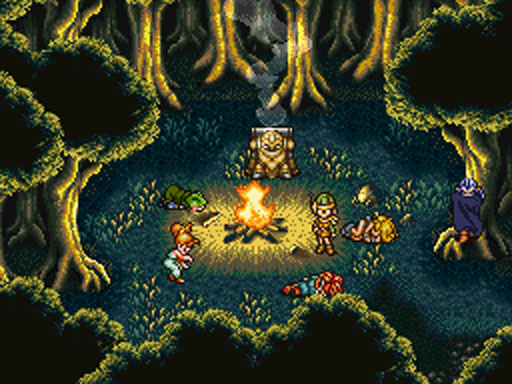
Chrono Trigger was the brainchild of several creative masterminds: Hironobu Sakaguchi, Yuji Horii, and Akira Toriyama, creators, respectively, of Final Fantasy, Dragon Quest and Dragon Ball. The fact that these men got together at a time when Final Fantasy and Dragon Quest were developed by different companies was the first clue something special was on the horizon.
By eschewing the tradition of random battles that whisked you away to a separate battle screen, Chrono Trigger quickly made it apparent that it was going to be a new experience. Right as the Final Fantasy series was implementing game systems that robbed characters of their uniqueness in battle, Chrono Trigger‘s battle system featured Techs, in which 2 or 3 characters could employ powerful abilities based on each party member’s unique skill set. While the plot ended up boiling down to the ‘prevent the apocalypse’ variety, the scope of the game’s events and the six different time periods visited set the title apart. Much like Homer Simpson’s time-traveling escapades, events in the distant past could have major implications on the world (and its treasures) of the present and future.
There’s more than a single reason the game grabbed people’s attention: Whether it was the eclectic cast, unique gameplay, memorable musical score, or the simple desire to fly across time and space in your own time machine, it was (and is still) hard not to find something to love in Chrono Trigger.
Now, can we get that third game, Square Enix? It’s about time.

